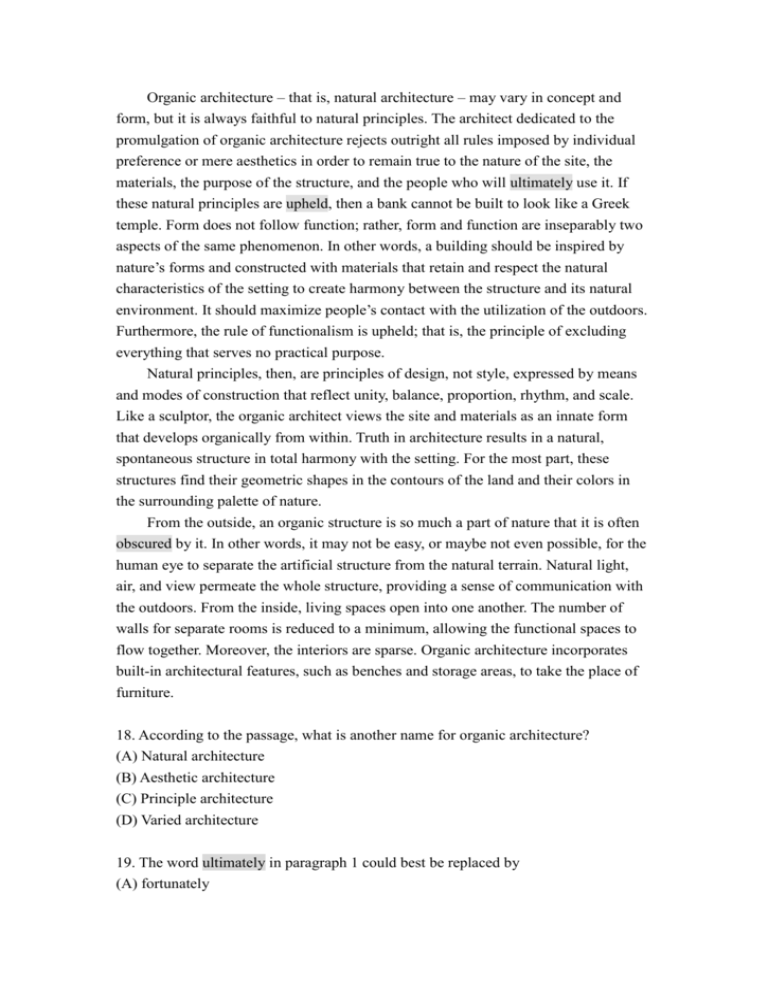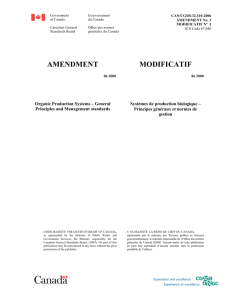Organic architecture – that is, natural architecture – may vary in
advertisement

Organic architecture – that is, natural architecture – may vary in concept and form, but it is always faithful to natural principles. The architect dedicated to the promulgation of organic architecture rejects outright all rules imposed by individual preference or mere aesthetics in order to remain true to the nature of the site, the materials, the purpose of the structure, and the people who will ultimately use it. If these natural principles are upheld, then a bank cannot be built to look like a Greek temple. Form does not follow function; rather, form and function are inseparably two aspects of the same phenomenon. In other words, a building should be inspired by nature’s forms and constructed with materials that retain and respect the natural characteristics of the setting to create harmony between the structure and its natural environment. It should maximize people’s contact with the utilization of the outdoors. Furthermore, the rule of functionalism is upheld; that is, the principle of excluding everything that serves no practical purpose. Natural principles, then, are principles of design, not style, expressed by means and modes of construction that reflect unity, balance, proportion, rhythm, and scale. Like a sculptor, the organic architect views the site and materials as an innate form that develops organically from within. Truth in architecture results in a natural, spontaneous structure in total harmony with the setting. For the most part, these structures find their geometric shapes in the contours of the land and their colors in the surrounding palette of nature. From the outside, an organic structure is so much a part of nature that it is often obscured by it. In other words, it may not be easy, or maybe not even possible, for the human eye to separate the artificial structure from the natural terrain. Natural light, air, and view permeate the whole structure, providing a sense of communication with the outdoors. From the inside, living spaces open into one another. The number of walls for separate rooms is reduced to a minimum, allowing the functional spaces to flow together. Moreover, the interiors are sparse. Organic architecture incorporates built-in architectural features, such as benches and storage areas, to take the place of furniture. 18. According to the passage, what is another name for organic architecture? (A) Natural architecture (B) Aesthetic architecture (C) Principle architecture (D) Varied architecture 19. The word ultimately in paragraph 1 could best be replaced by (A) fortunately (B) eventually (C) supposedly (D) obviously 20. The word upheld in paragraph 1 is closest in meaning to (A) invalidated (B) disputed (C) promoted (D) perceived 21. The following examples are all representative of natural architecture EXCEPT (A) a bank that is built to look like a Greek temple (B) a bank built so that the location is important to the structure (C) a bank that is built to conform to the colors of the natural surroundings (D) a bank that is built to be functional rather than beautiful 22. Why does the author compare an organic architecture to a sculptor? (A) To emphasize aesthetics (B) To give an example of natural principles (C) To make a point about the development of geometry (D) To demonstrate the importance of style 23. The word obscured in paragraph 3 is closest in meaning to (A) difficult to see (B) in high demand (C) not very attractive (D) mutually beneficial 24. With which of the following statements would the author most probably agree? (A) Form follows function. (B) Function follows form. (C) Function is not important to form. (D) Form and function are one. 25. Which of the following statements best describes the architect’s view of nature? (A) Nature should be conquered. (B) Nature should not be considered. (C) Nature should be respected. (D) Nature should be improved. KEY: A B C A B A D C







